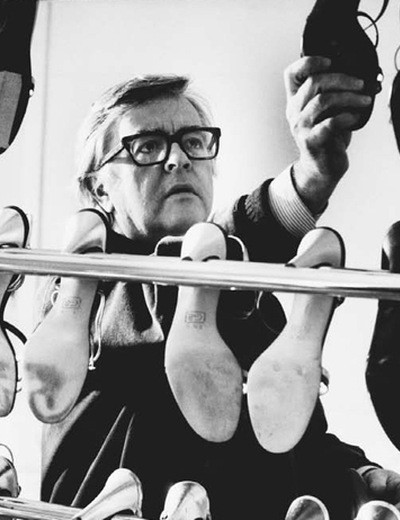
Geoffrey Beene
About
the designers
Geoffrey Beene, the American fashion designer born in 1927, loved movement and adored bodies in action.
Benne Planned to be a doctor like his grandfather and enrolled in medical courses at Tulane University, in New Orleans. However, his interest waned when the classes discussed vivisection and cadavers. So he dropped out, moved to California, took a temporary display job in the I Magnin store in Los Angeles in 1945.
The following year he entered New York’s Traphagen School in 1947 to study fashion for one year.
1948 he went to Paris attending the Academie Julian, and l'Ecole de la Syndicate d'Haute Couture, as well as sees his first French couture collection, stunned by the wit and iconoclastic use of colour of Elsa Schiaparelli.
From 1948 till 1950 working for Edward Molyneux, the great designer.
He returned to New York in 1951 and begins work with Mildred O’Quinn. Furthermore at the same time he worked for Samuel Winston, and then he was head designer at Harmay, a dress house on 7th Avenue.
He designed for Teal Traina, a major garment house, from 1954 to 1963.
1963 Geoffrey Beene set up his own house on 2nd Avenue in New York and showed his first collection. A dress from this first collection was on the cover of Vogue, Jean Shrimpton the top model of the day, was shown wearing his beaded top and white gabardine skirt. From the time he opened his business in 1963, Beene received the highest fashion honours, starting with the first of eight Coty American Fashion Critics’ awards in 1964. Two years later he brought grey flannel and wool jersey fabrics to ballroom gowns and won his second Coty award.
1968 Beene designed his "Mafia" collection, pin-striped suits which he dubbed "Alice Capone" as a joke, referring to the gangster Al Capone.
1969 he opened his first Men’s Wear Collection.
In 1974, he pioneered a lower-priced "Beene Bag" label for casual clothes that cost a fraction of his signature collections. He was among the first American designers to produce and sell his collections in Europe. He was also one of the first American designers to have a chain of boutiques in Europe and Japan.
Beene developed a menswear business that led to a licence agreement with Van Heusen for shirts. He also created fragrances for men and women.
1976 Beene was the first American designer to show his collections in Milan, Italy followed up with Rome, Paris, Brussels and Vienna.
1989 Beene opened his retail shop on 5th Avenue in New York, “Geoffrey Beene on the Plaza”.
In 1991 he became actively interest in Home Furnishing design.
1994 Honoured with a Retrospective exhibition at the Fashion Institute of Technology in New York.
1996 Lieutenant Governor of Louisiana proclaimed April 27th as "Geoffrey Beene Day" in the State. His designs were displayed in several galleries and museums, including New York’s Fashion Institute of Technology in 1994 and the Cooper-Hewitt National Design Museum in 2002.
He was an innovator in business as well.
He died in September 2004, at the age of 80, at his home in Manhattan, New York. Geoffrey had the last laugh, since the whole world reported that he was 77, although he had quietly celebrated his 80th birthday a short while earlier.
the label
Today's Geoffrey Beene Inc. is a fashion empire comprised of women's couture and men’s and women’s ready-to-wear, men's accessories and fragrance. With a dedicated design team at company headquarters working in concert with a network of premiere licensees, the Geoffrey Beene label continues to uphold the design aesthetic that was signature Beene. The Geoffrey Beene brand is carried throughout the U.S. in better department and specialty stores, and in Geoffrey Beene outlet stores. After Geoffrey Beene’s dead in 2004 the company continued unter the dirction of President G. Thompson Hutton, Senior Vice-President/Chief Operating Officer Russell Nardozza and Design Director Einar Holiloekk.
The women’s couture collection is exclusively housed at the company's New York City studio. Today, Geoffrey Beene woman's couture collection is exclusively housed at the company's atelier on 57th street in New York City under the direction of Beene protégé and design director Einar Holiloekk.
The Look
Beene made strong impressions with his courteous manner as well as his highly original style. On the one hand, he was a champion of minimalist design. The short, A-line dresses and body-contoured jumpsuits he was known for were marvels of cut and proportion. At the same time, his evening collections featured layers of fabrics and prints, some of them embroidered with dots and trimmed with delicate lace. Everything he designed had a hand-crafted, artisan’s quality that made more familiar-looking clothes seem predictable. Beene was among the first designers of his level to use fine-quality rayon and other synthetic fabrics for his collections, partly because they resisted wrinkles. He sometimes worked with Asian manufacturers to create his own prints. One memorable fabric reproduced the scales of a shark’s skin. Beene’s view of style was more about function than fad. He also cautioned against getting too concerned with the latest trends. His clothes were structured but never rigid and rely on the craftsmanship of careful detail. Many of his designs contained an element of fantasy. He had a casual approach to opulent fabrics, successfully blending them with less expensive materials, for example flannel trimmed with rhinestones, quilted ticking cotton with chiffon, or jersey with taffeta. He did much to blur the difference between sportswear and other clothes, like his strapless Grecian draped tennis frocks, or jogging clothes with glittering piping. He made rich and imaginative clothes and showed his creativity by designing with a relaxed elegance. From his high-priced couture collections, to his lower priced Beene Boutique and Bazaar lines, as well as his Beene Bag sportswear line, he offered flexible wardrobes of inter-related pieces. His colours could be bright and bracing like red, or earthy and subtle.